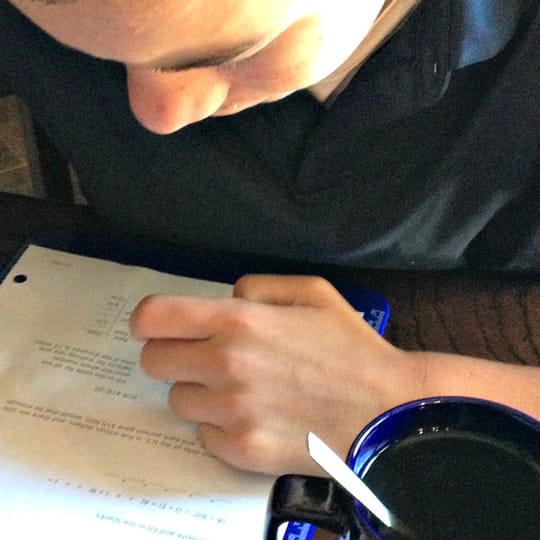
Personality and Learning Styles
Before thinking about personality and learning styles, you have to know what MBTI personality typing is. If you need to know the best personality test around, check out my resource page for all things personality.
Those of us educating young children tend to use the vocabulary of learning styles, though current research seems to be showing that most of the learning styles rhetoric is bunk.

Still, we do know that children are different. We know that there are different modes of and avenues for learning. There is value in reading, in hearing, and in doing. It turns out that personality and learning styles intersect, or, more accurately, personality steps in where learning styles falls short.
I believe that some of what people are describing when they speak about different learning styles can be tied back to personality. In fact, Isabel Briggs Myers has an entire chapter in her 1980 book, Gifts Differing titled “Learning Styles” as well as another chapter called “Type and Early Learning” (all quotes in this post are from this book).
In the midst of the see-and-say reading fad, Myers includes in her book on personality a defense of phonics and why phonics instruction works for all types, but how see-and-say only works for a select few types (hence, there are examples of it working that are valid, but they don’t prove it’s a valid method). Ns can spot patterns without realizing it, but Ss tend to need to know rules before they can figure something out. ESxx types, she says, are the students who struggle in early education and the ones who usually do not test well, because testing relies on mental speed and trusting your gut – something that typically comes naturally to INxx types, can be learned by other N and I types, but generally not by ESxx, who always want to double check and make sure before marking an answer. Personality and learning styles, then, are related.
In first grade the IN pupils are likely to be the quickest to catch on to the symbols and often are delighted with them. But the extravert children with sensing, the ES pupils, who make only minimal use of either intuition or introversion, may find the symbols so confusing that they become discouraged about the whole business of going to school. They may even decide, hopelessly or defiantly, that school is not for them
Listen to this post!
SC015: Learning styles are bunk, personality is not
Personality and Learning Style
Myers makes it clear that this difference presents a serious problem to our methods:
Confusion about symbols is a very serious matter. Children of any type are doomed to flounder in school if they do not learn the meanings of the symbols by which language is written and must be read. […] They will do badly on achievement tests and intelligence tests. They will probably be bored by what they do not understand and may well be humiliated because they do not understand it. […] Their failures may be blamed on low IQ or perhaps emotional difficulty, whereas actually the failures and the low IQ and the emotional difficulty could all result from one omission. Nobody helped them, in the beginning, to learn the explicit meaning of the sound-symbols.
I should note here that I know from personal experience that all IN-types do not read early – I was a late bloomer and was 8 before I could read. However, when I did learn to read, it was like a lightbulb switched on and I went from not-reading to reading in an intuitive flash and not with the slowly, gradually building ability by which my current 7-year-old ES child is learning to read. My three N children, despite being boys, were all early, intuitive, eager readers.
In her chapter on learning styles, Myers boils effective teaching and learning down to attention and communication. Hello, Charlotte Mason, I wasn’t expecting to meet you in this book.
These two essential components are affected by type. Type tells us what interests this person the most (that is, what do they naturally pay attention to) and how they best “catch on” to an idea through communication – both affected by the perception, whether N (intuitive – theories, patterns, thinking) or S (sensing – facts, seeing, doing).
Because words, the necessary medium of education, have to be translated from symbols into meaning by the listener’s intuition, the translation is naturally easier for intuitives than for sensing types. Intuitives use their favorite kind of perception, but sensing types have to use their less-liked, less-developed kind of perception, which takes more time and effort, especially when the words are abstract.
This doesn’t mean that S children are doomed, of course. But it means that if we have a child who seems slower on the uptake, it might not be because they aren’t as smart but that they require more time. We tend to equate speed with intelligence, but that isn’t a necessary correlation. Myers’ primary admonition to teachers is to simply be more patient and give students even 5 seconds thinking time before requiring an answer, and also to speak more slowly and deliberately – slowing down, she argues, immensely helps sensing students and doesn’t adversely affect intuitives either, as they can use the extra time to make the mental connections that come more naturally to them. Everyone benefits from slowing down the pace of a lesson.
Everything seems to be words, some of which may not be familiar enough to be meaningful. And the words go by so fast. Children are often caught in the same predicament as adults who are trying to converse with a foreigner in the foreigner’s language. Unfamiliar words take extra time to translate, and when the words go by too fast, translation becomes impossible.
Whether or not we have secured our student’s attention, interest, and understanding is of upmost importance. We are wasting our breath and our time if we don’t have those three things. In fact, we might even be doing harm if our goal is simply to move quickly through a lesson and be on to the next, without pausing and interacting to see if we still have attention, interest, and understanding every step along the way.
The children’s ability to cope is at stake here. In the unfamiliar world of school, they deeply need to feel adequate, and the best way to feel adequate is to be adequate. If they genuinely do well in their required tasks by using their perception (to understand the task) and judgment (to do it right), they strengthen both for future use. The satisfaction of knowing something new or being able to do something new will provide inner motivation for further effort and further development.
Personality and learning styles – what always works
Success builds upon success. This is why we must teach the student in front of us, not our ideal student or our own expectations or ourselves. It is the one – each one – we are teaching that needs to be built up, and we can’t do that if we aren’t paying attention to him as an individual, where he is in his ability and understanding in the moment. We can’t help him move farther along the path unless we are helping him take the next step from where he currently is.
However, if children consistently fail (or feel they are failing), the resulting discouragement may inhibit future effort and block not only the required learning but even more important, the development of the perception and judgment. The habit of failure is extremely costly for the child […] Required tasks should be simple and explicit, and they should make a definite contribution to the child’s knowledge or skill.
I think Charlotte Mason’s practical methods answer Myer’s observations perfectly. The words presented, whether spoken or read, are given in short chunks, allowing time to process the idea. The ideas do not fly by, but are handled singly and shortly. Breaks, alternating the kind of energy used, help especially the S children recover from the effort of paying attention to concepts rather than concrete things, which they prefer. Science, through nature study, is taught by paying attention to things rather than by more and more abstract words. Narration ensures communication, and allows the teacher insight into what is or is not capturing the child’s attention and interest. Narration allows the child time and space to form their response freely, rather than trying to determine what the teacher wants in fill-in-the-blank or multiple choice tests.
If we know our child’s type, we can better suit the lesson to capture their attention and interest. Intuitives want to know the principle, the theory, the why. Sensing students enjoy the practical application, the what, the how. All lessons and subjects have all these parts, but we as teachers probably emphasize the part that appeals to our own type rather than what appeals to our students’ types. But even if we have a class with a mix of types, we can present a lesson to include both parts to make sure we secure attention.
But while we can and should be aware of tactics to secure attention and to promote interest and to allow learning, we should not take it so far as to say intuitive types should only do theoretical work and never have to do hands-on experiments (drat, I wish we could), or that sensing types don’t have to bother with principles and are allowed to learn facts out of context. Once we’ve secured attention, we can teach any type of student the needed lesson, directing him toward Truth, Goodness, and Beauty, which exists abstractly as well as concretely.
We all need to use our senses and our intuition, letting one grow to the exclusion of the other isn’t proper development, either. One will likely always be stronger and preferred, but that doesn’t mean we can allow the other side to be excluded. A full-orbed understanding arises from both angles, taken together. But we as teachers can be more effective when we draw our students in from the angle at which they are most likely to succeed.
Even Myers herself makes this caveat:
A final word of warning may be in order. What is urged here is the use of interest as an aid to learning useful things, but never the acceptance of a lack of interest as an excuse for not learning things that need to be learned.
Practical Suggestions
She even has a practical suggestion:
When students are not interested in something that they must learn, they have two options. One is sheer application, which is not as prestigious as aptitude or as stimulating as interest, but it gets the job done. Application is most often used by J types, who run their outer lives with their judgment [what should be rather than observing what is] rather than their perception.
She continues with this charming story:
The other option was recommended to me at the age of four, in a conversation I remember word for word.
“Mother, what can I do?”
“Your closet needs to be straightened up.”
“But I’m not interested in my closet.”
“Well, get interested!”
That, in a nutshell, is the solution for students who find that application is the problem. There are a number of ways to get interested in an assignment, once the student takes a good look at it.
If we can help our students learn both the skill of application and the skill of “getting interested,” we will have served them well for anything further they have to do in their adult life. Both can become habits if we do not allow the student to sit back and complain and gripe and get themselves out of work by excuse-making.
Knowing type and how that affects learning style does not give excuses. It shows a way out of predicaments that are common to each type, if we take the time and energy to hold our children accountable for their work.





